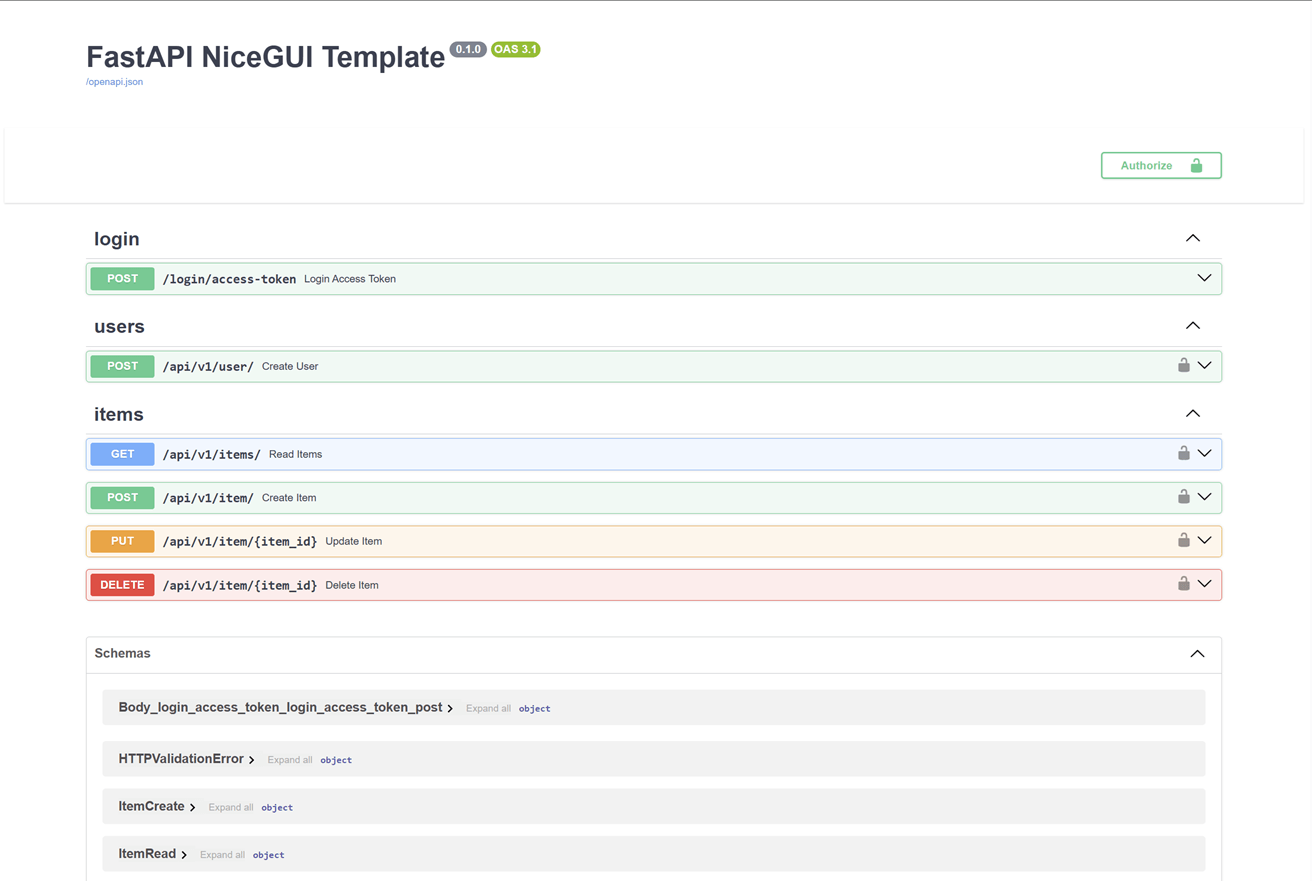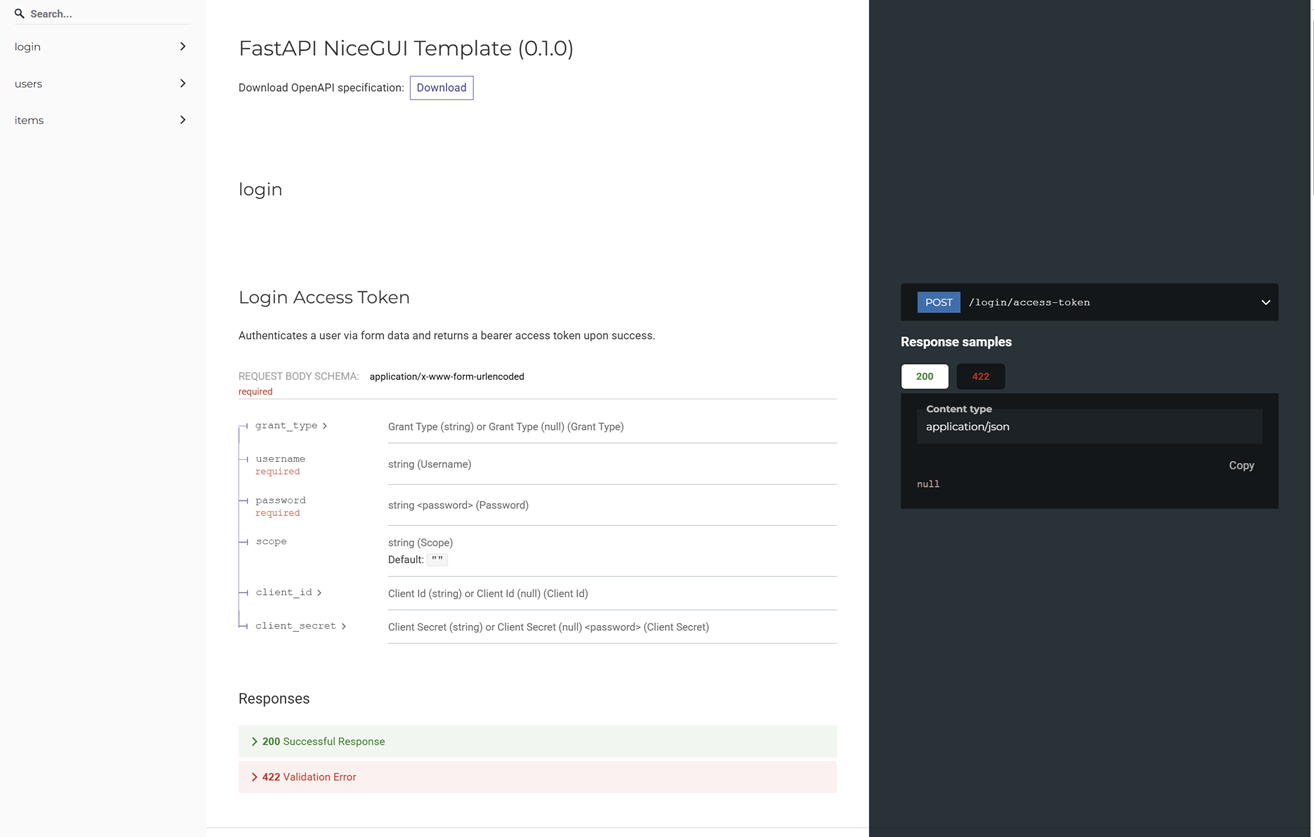The standard architecture for modern web applications involves a decoupled frontend, typically built with a JavaScript framework, and a backend API. This pattern is powerful but introduces complexity in managing two separate codebases, development environments, and the API contract between them.
This article explores an alternative approach: an integrated architecture where the backend API and the frontend UI are served from a single, cohesive Python application.
We will provide a technical analysis of this architecture’s implementation by integrating FastAPI and NiceGUI, referencing the complete project template available at jaehyeon-kim/nicegui-fastapi-template.
FastAPI Backend
FastAPI provides a robust foundation for the backend due to several key technical features:
- ASGI Foundation: Built on the Asynchronous Server Gateway Interface (ASGI), FastAPI natively supports asynchronous operations. This allows it to handle high-concurrency, I/O-bound tasks, such as network requests and database queries, efficiently without blocking the server.
- Schema Generation and Data Validation: FastAPI uses Pydantic models for strict, type-hint-based data validation and serialization. These models automatically generate OpenAPI schemas, which power the interactive API documentation (via Swagger UI and ReDoc) and ensure that the API contract is clearly defined and enforced.
- Dependency Injection System: Its dependency injection system is a core feature that enhances modularity and testability. It allows for the management of dependencies like database sessions and authentication credentials, ensuring that resources are correctly provisioned and cleaned up for each request.
NiceGUI Frontend
NiceGUI serves as the frontend component, allowing for UI development entirely within Python.
- Pythonic Abstraction of Web Technologies: NiceGUI functions as an abstraction layer that generates the necessary HTML, CSS, and JavaScript from Python objects and methods. This allows developers to define complex user interfaces without writing client-side code directly.
- Server-Side Event Handling: The framework employs an event-driven model where UI components are bound to Python callback functions. User interactions (e.g., button clicks, form submissions) trigger these functions, which execute on the server. This creates a direct and clear link between a UI event and its corresponding backend logic.
- Server-Maintained State: Unlike JavaScript frontend frameworks that manage state on the client, NiceGUI maintains the UI state within the server’s Python process. This simplifies application logic, as there is no need for complex state synchronization mechanisms between client and server.
Architectural Advantages and Framework Comparisons
The Integrated Server Approach
In this architecture, the NiceGUI application is mounted directly onto the FastAPI instance. This is typically done with a single function call, creating a unified application that serves both API endpoints and the user interface from one process.
The primary benefit is the ability to use shared data models (e.g., SQLModel or Pydantic) across the entire stack. A model defined once can be used to structure a database table, validate an API request payload, and define the data contract for the UI. This ensures end-to-end data consistency and reduces code duplication, as all parts of the application are built around the same data structures.
NiceGUI vs. JavaScript Frameworks (e.g., React, Vue)
- Bridging the Expertise Gap: Acquiring deep expertise in both backend Python and a modern JavaScript frontend framework is a significant undertaking. NiceGUI directly addresses this by enabling Python developers to build sophisticated user interfaces without leaving the Python ecosystem. This allows them to leverage their existing skills rather than learning a new language and its complex toolchain.
- Leveraging Mature Frontend Technologies: NiceGUI is not a proprietary UI system built from scratch. It is built on top of the robust and widely-used Vue and Quasar frameworks. This provides the best of both worlds: developers interact with a simple Pythonic API while benefiting from the power, performance, and rich component library of a mature frontend technology.
- Trade-offs: The server-side rendering approach is highly efficient for internal tools and data-heavy applications. However, because every interaction requires a round-trip to the server, it may introduce latency on highly interactive UIs compared to a client-side Single Page Application (SPA), which can handle many state changes without network requests.
NiceGUI vs. Streamlit
- Control and Layout: NiceGUI provides more granular control over UI component placement and application layout, using rows, columns, and grids. This makes it well-suited for building applications with a structured, traditional design. Streamlit is more opinionated, favoring a simple, top-to-bottom script execution model that is excellent for linear data narratives but offers less layout flexibility.
- Event Handling and Execution Model: Both frameworks use callbacks, but their underlying execution models differ significantly. NiceGUI uses a persistent component model where an event, such as a button click, executes a specific callback function (
on_click=handle_click). This function is the only code that runs and is responsible for explicitly updating any UI elements. This aligns closely with traditional GUI programming paradigms. In contrast, Streamlit uses a script re-run model. While it also has anon_clickcallback, this function typically modifies a session state object. After the callback completes, Streamlit re-runs the entire application script from top to bottom. The UI is then re-rendered based on the new values in the session state. This model simplifies the creation of linear, data-centric apps but can be less direct and potentially less performant for managing complex, multi-state interfaces compared to NiceGUI’s explicit event-driven approach. - Integration: NiceGUI is designed to be a component that can be integrated with standard web frameworks like FastAPI. Streamlit is generally used as a self-contained application server and is less straightforward to embed within another ASGI application.
Implementation Overview
To provide a concrete example of this architecture, the reference repository at jaehyeon-kim/nicegui-fastapi-template contains a fully functional application. Let’s examine its structure and key components.
Project Structure
The project is organized into two main directories, ensuring a clear separation of concerns between the backend logic and the user interface:
backend/: This directory contains all the FastAPI source code. It is further subdivided into modules for handling specific responsibilities:api/: Defines the API endpoints for resources like users and items.db/: Manages the database session and engine configuration.models/: Contains the SQLModel (and Pydantic) data schemas that define our database tables and API data structures.repositories/: Implements the data access layer, abstracting the database queries from the API endpoints.
frontend/: This directory holds all the NiceGUI code for the user interface, organized by function into the following subdirectories and modules:components/: Contains reusable UI elements and helper functions. This includes visual components likeheader.pyandfooter.py, as well as utility modules likenotifications.pyfor displaying messages to the user andform_helpers.pyfor handling common form logic.layouts/: Defines the overall structure of the application’s pages. Thedefault.pyfile, for instance, assembles the header, drawer, and footer to ensure a consistent look and feel across different views.pages/: Each file in this directory represents a specific page or view within the application, such as the login screen (login.py), the item management page (items.py), and the user creation form (create_user.py).state.py: A dedicated module for managing the application’s client-side state, such as user authentication status. This allows different parts of the UI to react consistently to changes in state.
backend/main.py: This file serves as the central integration point. It initializes the FastAPI application, includes the API routers from thebackend/api/directory, and finally, mounts the entire NiceGUI frontend. This is where the two parts of the application become one.
Application Demo
The repository provides a complete user and item management application that showcases role-based access control. The functionality is divided between two user roles:
Standard User: After logging in, a standard user has full CRUD (Create, Read, Update, Delete) permissions over their own items. They can add new items, view their list, and edit or delete them as needed.
Superuser: A superuser has elevated privileges. In addition to managing their own items, they can also create new user accounts. Crucially, they have a global view of the system and can manage the items belonging to any user, making this role suitable for administrative purposes.

The demo showcases these distinct workflows, illustrating how the NiceGUI frontend dynamically adapts to the user’s permissions, which are enforced by the FastAPI backend.
Automatic API Documentation
One of the most powerful features of FastAPI is its ability to automatically generate interactive API documentation from the Pydantic models and endpoint definitions. The application provides two documentation interfaces out-of-the-box:
- Swagger UI (
/docs): A feature-rich, interactive interface that allows developers to not only view the API endpoints but also test them directly from the browser by sending live requests.

- ReDoc (
/redoc): A clean, read-only documentation page that presents the API in a more traditional, hierarchical format. It is excellent for quickly referencing endpoints and their schemas.

These auto-generated documents are invaluable for development, testing, and collaboration, and they are created without any extra effort, thanks to FastAPI’s adherence to the OpenAPI standard.
Summary and Use Cases
The integration of FastAPI and NiceGUI provides a robust architecture for building web applications entirely in Python. It streamlines development by creating a unified environment, simplifies deployment to a single process, and ensures strong data consistency through the use of shared models.
This architecture is exceptionally well-suited for:
- Internal Tools and Administrative Dashboards: Where rapid development and ease of maintenance are critical.
- Rapid Prototyping and MVPs: To quickly build and validate a functional application.
- Machine Learning and Data Science Demos: To create interactive interfaces for models without requiring frontend expertise.
While it may not be the optimal choice for every project, particularly those requiring complex client-side interactivity, it offers a powerful and efficient alternative for a significant class of web applications. For a practical implementation, refer to the project code at jaehyeon-kim/nicegui-fastapi-template.










Comments